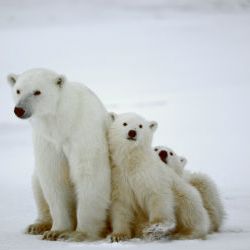Tourists Come Across Unique Sight Of 200 Polar Bears Feasting On Whale Carcass

A group of people on a boat tour in the far Eastern Russian Arctic didn’t know what they were seeing for a good few minutes until they realised that there were as many as 200 polar bears roaming on the slope of a mountain. The tourists said they were gobsmacked by what can only be described as a completely unique situation. The bears were there to feed on the carcass of a bowhead whale that had washed ashore. After eating their fill, they then rested near the source of their meal. The group of bears included a number of families including a couple of mothers who were being trailed by four cubs each.
Climate change is changing polar bear behaviour
Climate change has meant that sea ice has started form much later in the year and the ice is necessary for the bears to hunt seals which is the main constituent of their diet. Lack of ice means bears are now being forced to spend more time on land than they ordinarily would and whilst the sight of 200 polar bears may have been exciting for tourists, in reality more bears are being crammed together on coasts and islands and will have to compete for what limited food is available on land.
Hungry bears
Hungry bears also wander into villages which puts locals at risk. A whale however represents a real gift because an adult whale weighs several tens of tonnes and can act as a source of food for a good few months. Studies have show that polar bears now spend an average of a month longer on land compared with two decades ago. The IUCN estimates that the Arctic serves as home to approximately 26,000 polar bears and there is potential for a large reduction in their population over the long term due to loss of sea ice.
Population is stable at the moment
For now, experts says the polar bear population in the Arctic sea area shared by the US and Russia seems to be both productive and healthy for now. However, as the amount of time they are forced to spend on land increases, their nutrition and body condition will be negatively impacted. Nobody is sure at what point the polar bear population will begin to experience the negative effects of climate change. Does a delay of one and half months for the sea ice to form impact them, or is it two months or more? There is obviously some threshold and we will only come to know what it is in the future.



